Rhubarb is a very popular plant with gardeners as it provides a huge crop and is a reliable plant, providing a harvest year after year. It is easy to grow, very forgiving and requires minimal maintenance, making it ideal for a corner of your allotment or garden.
It makes for delicious desserts and freezes well, allowing you to store it for use outside of the growing season. It is typically quite expensive in the shops yet is a prolific plant that isn’t difficult to grow. The issue is that fresh rhubarb doesn’t store very well and needs using or freezing for it to keep.
Rhubarb is so easy to grow that it has a reputation for thriving on neglect! If you give it a bit of care, which you will learn in this article, you will end up with an excellent crop!
Choosing Your Rhubarb
You can grow rhubarb from seed, but you must be patient as it will be at least two years before you can harvest any stems. Unfortunately when growing from seed rhubarb doesn’t always grow true to type so you can end up with a different variety to that you thought you were growing.
It is far easy to buy rhubarb crowns (also known as budded pieces). These are part of a mature rhubarb plant that has been divided. The first year these new crowns produce stems you must resist the temptation to harvest them as this will weaken the plant. The following year though you can enjoy a bumper crop of rhubarb.
What Variety To Grow
There are a number of different varieties of rhubarb available, some of which need planting in spring and some in autumn. Buy the right variety for when you are planting it. Rhubarb is worth the investment because a healthy plant will continue to be produce for ten to twenty years, and sometimes more! The following list shows you some of the more common varieties and when they need planting.
- Champagne – autumn / spring
- Victoria – autumn / spring
- Timperley Early – autumn / spring
- Stockbridge Arrow – autumn
- Raspberry Red – autumn
- Giant Grooveless Crimson – spring
- Spring – Keep an eye out for flower stalks and remove them as they appear. A good feed of general purpose fertiliser will give them a healthy boost.
- Summer – Keep well watered in dry spells. Remember to water regularly if you are growing in containers.
- Autumn – Remove dying and dead leaves to expose the buds to the cold. Apply a mulch of well-rotted manure around the crown, being careful not to cover it.
- Winter – Divide the crown every 5 or 6 years. Lift the crown and use a spade split each crown into 3 or 4 pieces, making sure a healthy looking bud is on each piece. Plant each piece separately.
Where To Plant Rhubarb
Rhubarb crowns are planted either in spring or autumn, when the soil is moist and warm. If you are planting out a potted rhubarb plant then you can get away with planting it pretty much any time of the year. Just make sure that the soil isn’t too dry, waterlogged or frozen.
Rhubarb is an undemanding plant but it does not like being disturbed so if you are not sure where you are going to plant it, keep it in a pot until you do! Rhubarb will grow quite happily in a pot that is at least 20″ deep and wide. Your rhubarb needs a permanent bed where it can grow without any disturbance for years.
Choose a spot that is open and sunny with moist but free-draining soil. Rhubarb does not like getting waterlogged in the cooler months and the stems will be damaged by a frost.
Once you have your crowns you need to dig a decent sized hole to plant it in. Prepare the soil first though by digging down about two feet and digging in well rotted manure. Do not add fresh manure as the heat will burn the roots of your rhubarb plant. Clear away all weeds and weed roots before planting. Proper preparation will give your plant the best start in life, ensuring a strong and healthy root system.
The crown needs to be placed in the soil so that the top of the crown is 1″ below the soil level. If your soil is wet and heavy then sit the top of the crown at ground level to help prevent crown rot. Rhubarb plants will grow to a good size, so leave a good 30″ between plants.
Cover the ground with a good mulch of manure, though do not bury the crown as it will rot. In March you should feed the rhubarb with a good quality general purpose fertiliser. Throughout the growing season water the plant regularly in dry spells.
You may see your rhubarb plant produce a long stem in the spring. This will turn into a flower and should be removed as soon as it appeared. A single plant can produce multiple flowers. If you allow it to set seed then this will weaken the plant.
In the autumn, the top growth will die back and you need to remove the leaves as they die back. These can be composted or left in place to break down in the soil. Personally I remove them as they provide a haven for slugs and snails on my allotment. This exposes the crown to frost which is needs the following year to come out of dormancy and produce a healthy crop.
Tips and Tricks
Although rhubarb is low maintenance, giving it a bit of care and attention will ensure you get the best possible crop.
Common Problems
Rhubarb is a relatively easy plant to grow and won’t have too many problems if it is planted in the right location and cared for.
One of your biggest issues will be slugs and snails which will eat the leaves and feed on young seedlings. Use your preferred method of dealing with these pests and remove them. I’d recommend keeping your rhubarb plot clear of debris and possible hiding places as that will reduce the incidences of these pests.
Aphids can sometimes be a problem, being found in the soft tips of the leaves. If these are a problem then either spray them, use a biological control or squash them with your fingers if there are only a few.
Crown rot is one of the most commonly problems you will encounter with rhubarb. However, if you have planted it properly and made sure it is in a free draining soil then this will be much less of a problem. If you do encounter this then cut away damaged plant material and destroy it.
Harvesting Rhubarb
I love rhubarb and particularly apple and rhubarb crumble. It is a special treat from the allotment which I relish because it is so expensive to buy in the shops yet so cheap and easy to grow! Harvest season starts in April and will run through to July. You can continue to harvest established plants after this time, but do not take too much as your plants need to build their reserves for winter. After July you can find the stems are not as sweet as they are earlier in the season.
In the first year of growth you should not harvest any stems as the plant needs to get established. The stems are harvested from the second year on when the leaves are completely unfurled and the stems are at least a foot long.
To harvest you carefully pull each rhubarb stalk from the base of the stem and then with a twisting motion pull it away from the crown. Don’t take more than you need so just take a few at a time to avoid damaging the plant. You should never harvest more than half of the stems at once.
Ideally you want to finish harvesting by July. Don’t worry if you have a glut of rhubarb. It freezes very well when stewed and can then be used in any dish during the cooler months.
Remember that rhubarb leaves are poisonous (they contain oxalix acid) so they should never be eaten. Cut the leaves off the stems and compost the leaves.
Forcing Rhubarb
You can force rhubarb so that you get an earlier crop. However, if you do this you need to give the plant a rest the following year. Do not force the same rhubarb crown two years in a row as it will weaken the plant and even kill it. Forcing works best if you have several plants.
In January, cover your rhubarb crown with a layer of straw. Then place a large container, a pot, bucket or dustbin will do, over the crown. This is designed to exclude the light and make the crowns grow. You should be able to harvest rhubarb about eight weeks after it has been covered, which is typically about a month earlier than normal.
Rhubarb Crumble
Although there are many potential uses for rhubarb, my favourite by far is crumble. This is a delicious dessert, particularly over winter and is great served with custard.
For a good sized crumble you will need 3 or 4 stalks of rhubarb, though if you are using other fruits as well then you can use less. Cut the rhubarb into half inch long chunks and stew it in a pan with a few tablespoons of water. Add sugar or sweetener to taste. I’d recommend adding a bit, tasting it and repeating until you get it as sweet as you like.
Rhubarb can be stringy so either run a potato peeler down the back of it to get rid of the stringy bits or remove them as you cut the stalks into chunks.
Alternatively you can mix the rhubarb with other fruit. I use apples, pears, blackberries and mixed frozen fruit in my crumbles. In fact, any fruit that comes off of the allotment gets thrown in with the rhubarb! It is best to add this fruit to the rhubarb before adding sugar as the other fruit will sweeten the rhubarb.
Heat the fruit in a large pan over a low heat, careful not to boil it, until it becomes a pulpy mixture. This is then poured into an ovenproof pan and the crumble topping applied.
You can make your own crumble topping or you can use a store bought one (which is much easier).
To make a crumble topping you will need 100g (3.5oz) plain flower, 80g (3oz) butter, 80g (3oz) caster sugar and 80g (30oz) ground almonds. Add all of these to a bowl and rub them together until they form a consistency like breadcrumbs. This can be toasted in the oven before being put on top of the fruit mixture.
Scatter golden sugar on top of the crumble topping together with spices to taste such as cinnamon, ground ginger or ground nutmeg.
Bake it in the oven at about 180C for between 30 and 45 minutes until it is heated throughout.
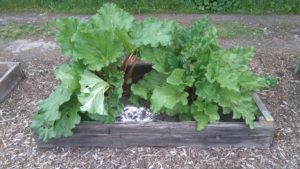
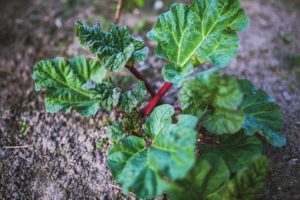
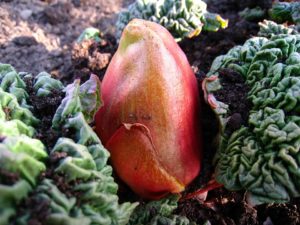
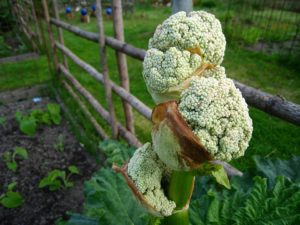
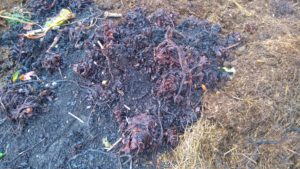

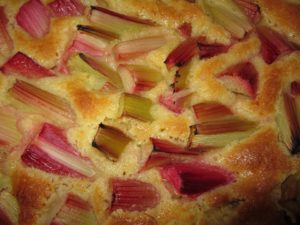
























Speak Your Mind